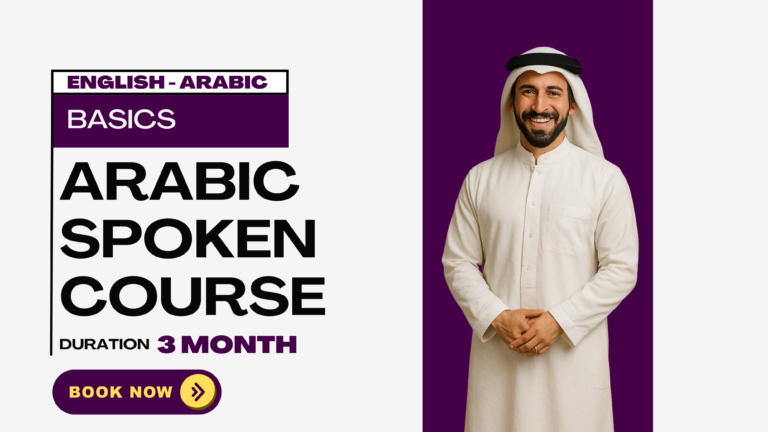Mastering the Foundation of Arabic Grammar
Have you ever wanted to speak Arabic like a local Khaleeji? The first step is simple but powerful—learning the Arabic alphabet. Think of the alphabet as your toolkit. Once you know how to use each letter, especially with a Gulf twist, the rest of Arabic grammar becomes far less intimidating.
This isn’t your average “Alif to Yaa” lesson. Here, we’ll explore how Gulf dialects pronounce the Arabic alphabet differently, where to watch out for sound shifts, and how to build pronunciation confidence from Day 1.
Why Start with the Alphabet?
Arabic is written in a beautiful script, flowing right to left, and made up of 28 letters. Unlike English, each letter can change form depending on its position in a word—beginning, middle, or end.
But even more importantly for Gulf Arabic learners, pronunciation differs across the Arab world. The way someone from Egypt says “ج” (jeem) sounds very different from how someone in Kuwait or Saudi says it.
So, if you’re aiming to speak like a Gulf native, it’s crucial to learn:
- How each letter is pronounced in Gulf dialects
- Where locals bend the rules
- Which letters are commonly dropped or softened in casual speech
Arabic Alphabet Table with Gulf Pronunciation Tips
Below is a table showing each Arabic letter, its name, standard pronunciation, Gulf Arabic variation (if any), Romanization, and an English example or note.
| Letter | Name | Roman Script | Standard Pronunciation | Gulf Variation | Example / Note |
|---|---|---|---|---|---|
| أ | Alif | A | A as in “apple” | — | Long vowel /a:/ |
| ب | Baa’ | B | B as in “bat” | — | Consistent |
| ت | Taa’ | T | T as in “top” | — | Consistent |
| ث | Thaa’ | Th | Th as in “think” | S or T | Gulf dialect softens to S or T |
| ج | Jeem | J | J as in “judge” | Y or Zh | In Gulf: “جَمال” → Yamal |
| ح | Haa’ | Ḥ | Harsh H (breathy) | — | From throat |
| خ | Khaa’ | Kh | Scottish “loch” | — | Throaty, raspy |
| د | Daal | D | D as in “door” | — | Consistent |
| ذ | Dhaal | Dh | Th as in “this” | Z or D | Often pronounced “Z” |
| ر | Raa’ | R | Rolled R | Softer roll | Not as trilled as Levantine |
| ز | Zay | Z | Z as in “zoo” | — | Consistent |
| س | Seen | S | S as in “sun” | — | Consistent |
| ش | Sheen | Sh | Sh as in “ship” | — | Consistent |
| ص | Saad | Ṣ | Heavy S | — | Emphatic |
| ض | Daad | Ḍ | Heavy D | — | Unique to Arabic |
| ط | Taa’ | Ṭ | Heavy T | — | Emphatic |
| ظ | Zaa’ | Ẓ | Heavy Th/Zh | Often “Z” | Simplified in Gulf dialect |
| ع | Ayn | ʿ | Deep throat sound | Softer in Gulf | Like a grunt from the throat |
| غ | Ghayn | Gh | French “R” | — | Gargled sound |
| ف | Faa’ | F | F as in “fun” | — | Consistent |
| ق | Qaaf | Q | Deep K | G | Gulf: “قهوة” → Gahwa (coffee) |
| ك | Kaaf | K | K as in “kite” | — | Consistent |
| ل | Laam | L | L as in “lamp” | — | Consistent |
| م | Meem | M | M as in “man” | — | Consistent |
| ن | Noon | N | N as in “nose” | — | Consistent |
| هـ | Haa’ | H | Soft H | — | Consistent |
| و | Waaw | W or U | W or “oo” | — | Long vowel or consonant |
| ي | Yaa’ | Y or I | Y or “ee” | — | Long vowel or consonant |
Gulf-Specific Pronunciation Insights
Let’s look at a few standout examples that often trip up learners:
- Jeem (ج)
Standard: “Jamāl” → جَمال
Gulf: “Yamal” → يُمال or sometimes “Zhamal” in Bahraini Arabic. - Qaaf (ق)
This is a classic Gulf marker!
Standard: “Qahwa” → قهوة
Gulf: “Gahwa” → G ق sounds like hard G - Thaa (ث) and Dhaal (ذ)
Often simplified:- ث → س or ت
- ذ → ز or د
For example: - ثَوب (Thawb, traditional dress) → pronounced Tawb
- ذَهَب (Gold) → pronounced Zahab
Short Conversation Using Gulf Pronunciation
Here’s a fun, practical exchange using the alphabet sounds we just learned.
Arabic Script:
أ: شلونك؟
ب: تمام، وإنت؟
أ: والله بخير، شفت جاسم اليوم؟
ب: أي شفته، رايح القهوة مع ناصر.
Roman Script:
A: Shlonak?
B: Tamaam, winta?
A: Wallah bikhair, shift Jaasim alyawm?
B: Ee shiftah, rayiḥ al-gahwa maʿ Naasir.
English Translation:
A: How are you?
B: Fine, and you?
A: I’m good, did you see Jassim today?
B: Yes, I saw him. He went to the coffee shop with Nasser.
Word-by-Word Analysis:
| Arabic | Roman | English |
|---|---|---|
| شلونك؟ | Shlonak? | How are you? |
| تمام | Tamaam | Fine |
| وإنت؟ | Winta? | And you? |
| والله بخير | Wallah bikhair | I swear I’m well |
| شفت | Shift | I saw |
| جاسم | Jaasim | Jassim (name) |
| اليوم | alyawm | today |
| رايح | rayiḥ | going |
| القهوة | al-gahwa | the coffee shop |
| مع ناصر | maʿ Naasir | with Nasser |
Easy Exercises to Practice
📝 Try writing your name in Arabic:
Use this tool to convert: Lexilogos Arabic Keyboard
🔊 Listen to Gulf pronunciation:
follow YouTube channels
🎧 Audio Drill Tip:
Record yourself saying the alphabet out loud with Gulf-style pronunciation. Then compare it with native Gulf speakers. Adjust your “ج” to sound like “Y” and your “ق” like “G.”
Common Mistakes to Avoid
- Ignoring dialectal differences. Don’t memorize the Egyptian or Levantine sound of a letter if you’re learning Gulf Arabic.
- Over-pronouncing emphatic letters. Gulf speakers tend to soften some letters naturally.
- Skipping throat letters. Learn ع (Ayn) and غ (Ghayn) early—even if it feels awkward.
FAQs about Gulf Arabic Grammar – Lesson 1: Alphabet & Pronunciation
Conclusion: The Alphabet is Your Gateway to Gulf Arabic Grammar
Learning the Arabic alphabet isn’t just about memorizing letters—it’s about training your ear and tongue to speak like a Gulf local. By focusing on pronunciation from Day 1, you build a solid foundation for mastering Gulf Arabic grammar in context.
Whether you’re headed to Dubai, Riyadh, or Kuwait City, speaking with the right sounds will earn you instant respect—and maybe a free gahwa too!
💡 Ready to Go Deeper?
If you’re serious about learning to speak Gulf Arabic like a native:
👉 Buy the Arabic Spoken Course eBook (Gulf Edition)
👉 Join Our Live Gulf Arabic Classes
🎯 Got questions about today’s lesson? Drop a comment or message—we love hearing from fellow learners!












